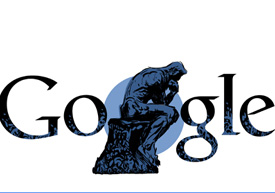Auguste Rodin’s 172nd birthday
The search engine has replaced the multicoloured Google logo on its homepage with an illustration depicting Auguste Rodin’s famous sculpture The Thinker.
Rodin (born in Paris in 1840) is widely believed to be the founder of modern sculpture.
A traditional sculptor who eschewed the predominant figure sculpture tradition of the times, Rodin’s work was initially unpopular, but gained momentum over the course of his life until he was a world-renowned artist by the time he reached his 60s.
Born into a working-class family, Rodin failed three times to win entrance to the Grand Ecole art college in Paris.
His rejection was a significant setback, and after his sister died five years later. When he was 22, he turned away from art, briefly joining a Catholic order.
Monday’s Google home page pays homage to the French sculptor Auguste Rodin on his 172nd Birthday. Auguste Rodin was born in November 12, 1840 in Paris into a working-class family.
Rodin was always fascinated by art and took up drawing when was ten years old. When he was 14 years of age, he enrolled himself at Petite Ecole, a school that specialised in art and mathematics where he studied drawing and painting for three years.
After passing out from Petite Ecole, Rodin applied to take admission in the Grand Ecole art college in Paris but failed to do so even after three attempts. After his rejection – he completely gave up the hope of being an artist and joined Catholic order. There he met Saint Peter Julian Eymard, who was the founder and head of the congregation. He was one of the first to spot the talent in Rodin and motivated him to get back to his sculptures.
Encouraged by his appreciation and support, Rodin created his first sculpture with the subject The Man with the Broken Nose, which was displayed in 1864. The scultpure featured a head that was ‘broken off’ at the neck, the nose flattened and crooked, and the back of the head was completely absent. Needless to say, it was not very well received by the critics.
Rodin was born Francois-Auguste-Rene Rodin in 1840 in Paris. He attended the Petite Ecole, where he studied drawing and painting. He tried to gain admittance to the Grand Ecole, but was rejected thrice. After he left the Petite Ecole, he worked as a craftsman and ornamenter for nearly two decades.
Rodin turned to religion after his sister Maria’s death in 1862, joining a Catholic order, the Congregation of the Blessed Sacrament. The founder and head of the congregation Saint Peter Julian Eymard, seeing his talent, encouraged him to continue with his sculpture. He studied under animal sculptor Antoine-Louis Barye, whose attention to detail greatly influenced him.
His work was a departure from traditional themes of mythology and allegory and was imbued with realism in depicting the human body.
He gained popularity with his first major, full-sized work, ‘The Age of Bronze’, which caused uproar with the statue’s extreme naturalism. Later, he was commissioned to work on his magnum opus, a sculptured portal in 1880. The project, called the Gates of Hell, was based on Dante’s ‘Inferno’. Some of the famous sculptures from the collection included the ‘The Thinker’ and ‘The Kiss.’
Rodin died on November 17, 1917 from lung infection.
